Papers by Sergey Slepchenko
Archaeological Research in Asia, 2018
This article presents an archaeoparasitological analysis of a child mummy from the medieval Zelen... more This article presents an archaeoparasitological analysis of a child mummy from the medieval Zeleniy Yar burial ground (12-13th centuries AD) located in the northern part of western Siberia. Analysis of samples from the intestinal contents of the child mummy revealed eggs of Opisthorchis felineus, suggesting that people of the region consumed raw or undercooked fish during the Middle Ages. Palynological data suggest that death probably occurred in the winter since this sample was free of 'environmental-type' pollen from wind-pollinated plants. The sample was also free of the so-called 'economic-type' pollen, suggesting that medicinal plants, namely different teas or herbs, had not been consumed, suggesting that no attempts were made to cure the ill child using these agents.
Antiquity, 2018
The identification of parasites in ancient human remains can address questions of past health, di... more The identification of parasites in ancient human remains can address questions of past health, disease, mobility and mortuary customs. Archaeoparasitological evidence from Russia is, however, almost absent. This study presents the first such evidence in the form of a helminth infection in a mummified individual from the southern Siberian site of Doge-Bary II, the burial ground of a nomadic Iron Age community. Despite the removal of the intestines as part of the mummification procedure, the residual eggs of Trichuris trichiura, a non-indigenous species of whipworm, were detected. This evidence provides the first confirmation of prehistoric contact between southern Siberian nomads and distant agricultural areas, such as China and Central Asia.

В статье приводится результат археопаразитологического и палинологического исследования образца и... more В статье приводится результат археопаразитологического и палинологического исследования образца из канализационного стока Чоргунской башни, расположенной на территории современного села Черноречье (Юго-Западный Крым). По результатам археологических исследований, время возведения донжона относится к третьей четверти XV в. В образце удалось выявить четыре вида яиц кишечных паразитов инвазирующих человека и синантропных животных.
Наличие яиц человеческого власоглава и аскарид указывает на относительно неблагополучное санитарное состояние данного фортификационного сооружения в отношении паразитарных и инфекционных желудочно-кишечных заболеваний.
Характеристика археопаразитологического спектра позволяет предположить возможное применение антигельминтных средств, либо употребление пищи, обладающей противопаразитарной активностью в отношении круглых червей. Непростая санитарно-эпидемическая обстановка осложнялась также и присутствием в Чоргунском донжоне синантропных грызунов — крыс и домашних мышей, которые могли являться постоянным источником опасных инфекций.
Результаты палинологического исследования содержимого канализационного стока позволили получить дополнительную информацию о питании людей, пользовавшихся отхожим местом в Чоргунском донжоне.
Немаловажным результатом исследования является демонстрация возможностей методов для исследования канализационных стоков и перспективность последних в качестве источника биоархеологической информации.

Russia, both as the USSR and the Russian federation, provided a source of parasitological theory ... more Russia, both as the USSR and the Russian federation, provided a source of parasitological theory for decades. A key figure in Russian parasitology was Yevgeny Pavlovsky. He developed the nidus concept of Pavlovsky provided the conceptual basis for the field of pathoecology. He also coined the term " Paleoparasitology ". Pathoecology is a foundation concept in archaeological parasitology. Paleoparasitology, as defined by Pavlovsky, is an avenue for understanding of host parasite evolution over very long time periods. These contributions are not fully recognized internationally. Similarly, the long history of Russian paleontological and archaeological investigations are not fully known. Most recently, discoveries from archaeological sites show that a pattern of zoonotic infection prevailed among archaeological populations in central Russia. This included a case of apparent host switching of beef tapeworm infection to reindeer. This latter discovery raises the possibility that archaeological parasitology can contribute to the new Stockholm Paradigm of ecological fitting, host switching, and emergent disease. This review covers all of the parasitological discoveries from ancient Russia and illustrates how Russian models and discoveries defined parasitological theory in the past and present.

This study addresses caries prevalence in Ayaly and Kaurdak-Sargat groups of Siberian Tatars livi... more This study addresses caries prevalence in Ayaly and Kaurdak-Sargat groups of Siberian Tatars living in the Omsk Region of the Irtysh. Judging by dental remains from the Okunevo VII and Bergamak II cemeteries (17th–18th centuries), the caries frequency among those people was similar to that in the late medieval population of northwestern Siberia. The diet of both these populations apparently consisted mostly of meat. However, a somewhat higher caries frequency among Siberian Tatars indicates a greater amount of carbohydrates. Later (18th to early 20th century) Tatars of Chertaly I, Toksay I and II, Tyulchakovo, and Letniy Kaurdak) exhibit a caries frequency similar to that found in 18th–19th century Russian peasants of western Urals, possibly evidencing a similar proportion of refined carbohydrates in the diet. Difference between earlier and later Tatar groups attests to an increasing role of agriculture due to the immigration of Russians and, later, of Tatars from the Volga-Ural region.
The Kulun-Atakh archeological culture of the Sakha [Yakut] people is described on the basis of bu... more The Kulun-Atakh archeological culture of the Sakha [Yakut] people is described on the basis of burials dated to the fourteenth through sixteenth centuries. This is a period before the arrival of Cossacks, when the Sakha were first practicing livestock herding in the vast territories of what is today the Sakha Republic (Yakutia). Recent dating techniques combined with new discoveries have made possible multidisciplinary research on Sakha origins.
The Kulun-Atakh archeological culture of the Sakha [Yakut] people is
described on the basis of bu... more The Kulun-Atakh archeological culture of the Sakha [Yakut] people is
described on the basis of burials dated to the fourteenth through sixteenth centuries. This is a period before the arrival of Cossacks, when the Sakha were first practicing livestock herding in the vast territories of what is today the Sakha Republic (Yakutia). Recent dating techniques combined with new discoveries have made possible multidisciplinary research on Sakha origins.
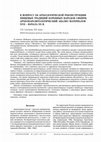
В статье обобщены результаты археопаразитологического исследования могильников, оставленных локал... more В статье обобщены результаты археопаразитологического исследования могильников, оставленных локальными группами коренного населения севера Западной Сибири (северные селькупы и тундровые ненцы с бассейна реки Таз). Проведено сопоставление полученных результатов с этнографическими материалами и дано краткое описание методики рхеопаразитологического исследования. Определено, что преобладающим гельминтозом у групп тазовских ненцев и селькупов являлся дифиллоботриоз, а основной пищей была сырая рыба. При этом рацион питания ненцев-рыболовов зоны лесотундры, оставивших могильник Нямбойто I, вероятно, в большей степени состоял из рыбы. Пища ненцев-оленеводов XIX века с реки Вэсакояха была разнообразной и кроме рыбы включала в себя мясо северного оленя. Селькупы XVII – XIX из Кикки-Акки, среди групп исследованного населения с реки Таз, занимают промежуточное положение.
Показано, что кормление детей сырой рыбой начиналось с раннего возраста. Подтверждены данные этнографических наблюдений о поедании сырого головного мозга северного оленя ненцами-оленеводами, что и являлось причиной их заражения тениаринхозом.
Намечено направление реконструкции путей сезонных миграции человека на территории Западной Сибири, основанное на территориальном различии в распространенности промежуточных хозяев некоторых гельминтов. На примере сопоставления территорий проживания северных селькупов, оставивших могильник Кикки-Акки, и зон распространения трематод вида Opisthorchis felineus показано, что ареал перемещений селькупов скорее всего ограничивалась бассейном реки Таз и возможно бассейнами рек Енисей и Пур. При этом сезонные перемещения селькупов из района современной фактории Кикки-Акки на реки Обь-Иртышского бассейна и употребление в пищу местной рыбы можно предположить маловероятными.
Данное исследование показывает перспективность рассмотрения археопаразитологических данных в этноархеологическом контексте с целью реконструкции пищевых традиций, структуры питания, типов хозяйственной деятельности, состоянии здоровья и некоторых других сторон жизни древнего и близкого к современности населения.
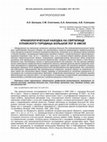
The paleoanthropological material discovered at a shrine in Bolshoy Log fortified settlement of t... more The paleoanthropological material discovered at a shrine in Bolshoy Log fortified settlement of the Kulay culture is of a big interest regarding the formation of the morphological type of the Kulay population. Despite the wide area of distribution (the Middle and Lower Ob River basin and adjacent territories of Western Siberia) and a long historical period of functioning (in the middle of the 1st millennium BC — the middle of the 1st millennium AD), there are only small data which would help to determine the morphological type of the Kulay population. These
are materials from the burial grounds of Kamenny Mys, Aldygan and single skulls from Ust-Poluy and Kulayskaya Gora shrines. Investigation of a skull from Bolshoy Log shrine showed that morphological features of the individual (a male of mature age) completely fits into the variability, typical of the very Kulay population, despite of high
individual variability. The morphological type of this male includes both Caucasoid and Mongoloid components. There are two trepanation holes on the skull, they were made after the skull had been separated from the body and after it had been cleaned off of soft tissues. The nature of holes location does not exclude a possibility of using it in ritual-magical actions. Facial reconstruction clearly demonstrates features of his appearance, which do not contradict a conclusion about the similarity of this male to a female from Ust-Poluy.
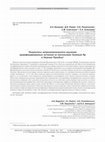
Комплекс археологических памятников Зеленый Яр расположен в 40 км от г. Салехард (ЯНАО). К настоя... more Комплекс археологических памятников Зеленый Яр расположен в 40 км от г. Салехард (ЯНАО). К настоящему времени опубликованы материалы 37 погребений, содержащих останки 43 чел. В восьми захоронениях XII–XIII вв. были обнаружены мумифицированные останки. В статье представлены результаты комплексного изучения наиболее хорошо сохранившегося мумифицированного тела мужчины из погр. 27. Исследование проводилось на основании компьютерной томографии. Ин-формативность полученных данных позволяет считать КТ-технологию «методом выбора» при анализе немацерированных останков. Доступность для осмотра не только наружных швов свода черепа, но и эндокрана позволила уточнить возраст смерти индивидуума – 45–55 лет. Были выявлены патологии зубочелюстной системы, скрытые под мягкими тканями: кариес и его осложнения в виде апикального периодонтита и остеоартроза левого височно-нижнечелюстного сустава. Также были обнаружены различные травматические повреждения и дегенеративно-дистрофические изменения опорно-двигательного аппарата. Для осуществления краниологического исследования и реконструкции лица мужчины на основа-нии компьютерной томографии было выполнено трехмерное моделирование цифрового изображения черепа и создана его объемная пластиковая копия. Анализ серии черепов XII–XIII вв. из могильника Зеленый Яр свидетельствует о монголоид-ности внешнего облика погребенных. В расовом отношении их можно отнести к ямало-енисейскому антропологическому типу западно-сибирской антропологической формации. Выраженными представителями данного типа в настоящее время являются сибирские тундровые ненцы. Это хорошо иллюстрирует реконструкция внешнего облика человека.
We present an arhaeoparasitological analysis of a unique burial from the Neftprovod II burial gro... more We present an arhaeoparasitological analysis of a unique burial from the Neftprovod II burial ground in East Si-beria, which dated from the Bronze Age. Analysis of a sediment sample from the sacral region of the pelvis revealed the presence of Taenia sp. eggs. Because uncooked animal tissue is the primary source of Taenia, this indicated that the individual was likely consuming raw or undercooked meat of roe deer, red deer, or elk infected with Taenia. This finding represents the oldest case of a human infected with Taenia sp. from Eastern Siberia and Russia.
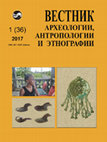
Женское погребение XVII века Атласовское-2 из Центральной Якутии: результаты комплексного исследования / The woman’s burial of Atlasovskoe-2 of the XVII century in Central Yakutia: results of a complex research, 2017
This article presents a complex study of the female burial of the XVII century in Central Yakutia... more This article presents a complex study of the female burial of the XVII century in Central Yakutia. The burial rite (traces of ritual roasting of the coffin, orientation to the North) and composition of the accompanying inventory (a knife of the non-Yakut origin, a sphero-conical top part of a headdress with a support for a plume, twin overlaid decorative details of the headdress’s crown, a composite pectoral panel picture of sewn-on patches, an earring in the form of a question mark with a biconical bead) determine the peculiarity of the burial, and their nearest parallels can be traced to the Medieval cultures of the Eurasian steppe and forest-steppe nomads, as well as to the population of the Siberian forest and tundra zones of the XVI–XIX centuries. Craniological characteristics of the buried woman draw her closer to the populations of Central Asian and Baikal anthropological types of the North Asian formation.

Afontova Gora II is a Late Palaeolithic site dated between 15000 and 11000 years BP. The archaeol... more Afontova Gora II is a Late Palaeolithic site dated between 15000 and 11000 years BP. The archaeological material is typical for the Afontova culture. The lithic industry is characterized by pebble tools and sidescrapers, as well as narrowfront and wedge-shaped microcores associated with microblade production. Raw material is dominated by small and big pebbles of alluvial origin from the Yenisei river bed (siltstone, argillite, sandstone, dolerite, quartzite, microquartzite). Big cores are not numerous and belong to either single-platform or radial types. Wedge-shaped microcores show a low level of standardization. The tool assemblage is dominated by big scrapers represented by a big variety of forms. The site yielded a number of anthropological finds, including a mandible and five teeth, which appear to have belonged to a young female of 14—15 years old. One more bone, a vertebrae, belongs to another female, who was older than 20 years. Some nonutilitarian
items, such as stone beads, a decorated ivory blade and ivory disks, were found too.
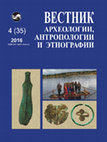
Комплексное исследование раннеякутского Сергеляхского погребения середины XV – начала XVI вв. / COMPREHENSIVE STUDY OF THE EARLY YAKUT SERGELYAKH BURIAL OF THE XV — BEGINNING OF THE XVI CENTURIES, Dec 12, 2016
The paper presents a comprehensive study of graves which relate to rare burial sites of the early... more The paper presents a comprehensive study of graves which relate to rare burial sites of the early stage of ethnic history of the Yakuts. The burial belongs to an equestrian warrior. It is confirmed by the findings of the horse harness and fragments of weapons, including a part of a Central Asian composite bow which is unique to the Yakuts, arrowheads and a blade of palma (Siberian pole weapon). The vertebral pathologies and morphological features of femurs also point at riding as a usual way of transportation. Multiple injuries of bones indicate to an aggressive lifestyle. The death of the man was caused by a penetrating injury of the head with a bladed weapon. Craniological characteristics of the man correspond to the South Siberian populations characterized by a combination of Caucasoid and Mongoloid features. In this case, the latter prevails. The ritual funerary complexes correspond to the Ust-Talkin culture, which alongside with cranial features of the man enable us to associate Sergelyakh burial with Turkic part of the Sakha people, which is epically correlated with the legendary Elley Bootur.
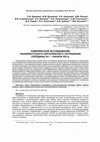
Представлены результаты комплексного исследования захоронения, относящегося к малочислен-ным погр... more Представлены результаты комплексного исследования захоронения, относящегося к малочислен-ным погребальным памятникам раннего этапа этнической истории якутов. Погребение принадлежит конному воину, о чем свидетельствуют элементы конной упряжи и фрагменты вооружения, в том чис-ле части уникального для якутов композитного лука центрально-азиатского типа, наконечники стрел, клинок пальмы. Патологии позвоночника и морфологические признаки бедренных костей также указы-вают на верховую езду как привычный способ передвижения. Многочисленные травмы на костях сви-детельствуют об агрессивном образе жизни. Смерть мужчины наступила в результате проникающе-го ранения головы, нанесенного клинковым оружием. Краниологические характеристики индивидуума находят соответствие в южно-сибирских популяциях, для которых характерно метисное сочетание европеоидных и монголоидных признаков, в рассматриваемом случае с преобладанием последних. Со-ответствие ритуальных признаков погребальным комплексам усть-талькинской культуры и кранио-логические особенности мужчины позволяют ассоциировать Сергеляхское погребение с «тюркской» составляющей народа саха, эпически соотносимой с легендарным Эллэй Боотуром. Ключевые слова: Сергеляхское погребение, усть-талькинская культура, якуты, кранио-метрия, череп, антропологический тип, палеопатология, популяция.
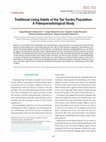
An excavation of the Vesakoyakha II-IV and Nyamboyto I burial grounds was conducted during the 20... more An excavation of the Vesakoyakha II-IV and Nyamboyto I burial grounds was conducted during the 2014 field season, and soil samples from intact burials dating from the 19th and 20th centuries, respectively, were analyzed to determine interactions between parasites and host/vectors. Considering the discovery of Diphyllobothrium sp. and Taenia sp. eggs in soil samples from the pelvic region, diphyllobothriasis was the most frequent helminthic infection among the Taz Nenets. The Nyamboyto Nenets mainly consumed uncooked fish, while the Vesakoyakha Nenets had a bigger variety in food choices, including reindeer meat. Nenets children were given raw fish from early childhood. The paleoparasitological results corroborate rare ethnographic records about the consumption of uncooked reindeer cerebrum which led to beef tapeworm helminthiases. This is the first parasitological report of helminthic diseases among the Taz Nenets, and, as such, it provides insight into their subsistence activities and food patterns and broadens our understanding of their health condition.
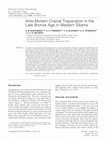
We report a case study of cranial trepanation in a male subject 30 to 40 years of age from the Ne... more We report a case study of cranial trepanation in a male subject 30 to 40 years of age from the Nefteprovod II burial ground in the Anzhevsk archeological site. This burial dates back to the Late Bronze Age, in particular the Karasuk culture located in the Minusinsk Basin on the Yenisei River and on the upper reaches of the Ob River. The left parietal bone had an opening with evident signs of bone healing, as well as signs of inflamma-tory reaction from both bone plates of the calvarium. The strongest signs of inflammation were located around the trepanation opening at the exocranium, suggesting that it occurred after, rather than before, the operation. Although trepanation was the main cause for the development of the changes noted in the preceding texts, there are no reasons to believe that the subject died from complications arising from infection after trepana-tion. The patient survived and later died for reasons that may never be determined. Medical necessity was the most likely justification for trepanation. Immersion in altered states of consciousness may also have been a necessary part of the trepanation process as a mode of sedation, along with other shamanic practices, such as consumption of psychotropic substances or ecstatic dance. These data, together with reports of other ante mortem burials, raised questions about the application of anaesthesia and possible techniques of cranial trepanation. These issues and possible postoperative complications are discussed in the following text.
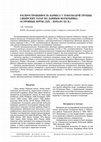
This paper examines caries prevalence in Tobolsk group of Siberian Tatars who left the Ostrovnye ... more This paper examines caries prevalence in Tobolsk group of Siberian Tatars who left the Ostrovnye Yurty
burial ground (19th – early 20th centuries).
The observed caries frequency and the caries rate adjusted using proportional correction factor (PCF)
were 3.3% and 11.6%, respectively. The high value of the latter one points to a large caries prevalence in the
population under study.
Estimates of PCF calculated separately for each sex evidences a higher rate among males than in
females (14.3% and 7.8% respectively). I also found that the rate the PCF adjusted caries rate was higher in
the «matures» age category both in male and female groups than in younger age categories. Caries frequencies
were greater on posterior teeth that on the anterior ones in all age groups of both.
Caries frequency in the population under study was greater than that hunting and fishing societies of
West Siberia, it is similar to that in the Russian population of the Urals (Verkhoturie, Kamensk-Uralsk, Revda),
and close to that in the contemporaneity Selkup group of Vargananzhino and Ust-Balyk. Therefore, I may
infer that there existed similar food patterns in all aforementioned groups.
The author recommends use of PCF, which accounts for caries on teeth lost antemortem as well as
postmortem, hence generating a more differentiated and realistic estimates about caries frequency in past
populations.
The paper present an analysis of Neolithic interments from the settlment complexes on lake Merge... more The paper present an analysis of Neolithic interments from the settlment complexes on lake Mergen (lower Ishim bassin). The authors offer interpretation of the these context of community ritualism of the ancient population/







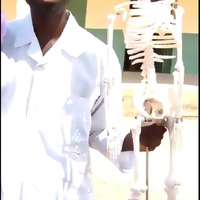
Uploads
Papers by Sergey Slepchenko
Наличие яиц человеческого власоглава и аскарид указывает на относительно неблагополучное санитарное состояние данного фортификационного сооружения в отношении паразитарных и инфекционных желудочно-кишечных заболеваний.
Характеристика археопаразитологического спектра позволяет предположить возможное применение антигельминтных средств, либо употребление пищи, обладающей противопаразитарной активностью в отношении круглых червей. Непростая санитарно-эпидемическая обстановка осложнялась также и присутствием в Чоргунском донжоне синантропных грызунов — крыс и домашних мышей, которые могли являться постоянным источником опасных инфекций.
Результаты палинологического исследования содержимого канализационного стока позволили получить дополнительную информацию о питании людей, пользовавшихся отхожим местом в Чоргунском донжоне.
Немаловажным результатом исследования является демонстрация возможностей методов для исследования канализационных стоков и перспективность последних в качестве источника биоархеологической информации.
described on the basis of burials dated to the fourteenth through sixteenth centuries. This is a period before the arrival of Cossacks, when the Sakha were first practicing livestock herding in the vast territories of what is today the Sakha Republic (Yakutia). Recent dating techniques combined with new discoveries have made possible multidisciplinary research on Sakha origins.
Показано, что кормление детей сырой рыбой начиналось с раннего возраста. Подтверждены данные этнографических наблюдений о поедании сырого головного мозга северного оленя ненцами-оленеводами, что и являлось причиной их заражения тениаринхозом.
Намечено направление реконструкции путей сезонных миграции человека на территории Западной Сибири, основанное на территориальном различии в распространенности промежуточных хозяев некоторых гельминтов. На примере сопоставления территорий проживания северных селькупов, оставивших могильник Кикки-Акки, и зон распространения трематод вида Opisthorchis felineus показано, что ареал перемещений селькупов скорее всего ограничивалась бассейном реки Таз и возможно бассейнами рек Енисей и Пур. При этом сезонные перемещения селькупов из района современной фактории Кикки-Акки на реки Обь-Иртышского бассейна и употребление в пищу местной рыбы можно предположить маловероятными.
Данное исследование показывает перспективность рассмотрения археопаразитологических данных в этноархеологическом контексте с целью реконструкции пищевых традиций, структуры питания, типов хозяйственной деятельности, состоянии здоровья и некоторых других сторон жизни древнего и близкого к современности населения.
are materials from the burial grounds of Kamenny Mys, Aldygan and single skulls from Ust-Poluy and Kulayskaya Gora shrines. Investigation of a skull from Bolshoy Log shrine showed that morphological features of the individual (a male of mature age) completely fits into the variability, typical of the very Kulay population, despite of high
individual variability. The morphological type of this male includes both Caucasoid and Mongoloid components. There are two trepanation holes on the skull, they were made after the skull had been separated from the body and after it had been cleaned off of soft tissues. The nature of holes location does not exclude a possibility of using it in ritual-magical actions. Facial reconstruction clearly demonstrates features of his appearance, which do not contradict a conclusion about the similarity of this male to a female from Ust-Poluy.
items, such as stone beads, a decorated ivory blade and ivory disks, were found too.
burial ground (19th – early 20th centuries).
The observed caries frequency and the caries rate adjusted using proportional correction factor (PCF)
were 3.3% and 11.6%, respectively. The high value of the latter one points to a large caries prevalence in the
population under study.
Estimates of PCF calculated separately for each sex evidences a higher rate among males than in
females (14.3% and 7.8% respectively). I also found that the rate the PCF adjusted caries rate was higher in
the «matures» age category both in male and female groups than in younger age categories. Caries frequencies
were greater on posterior teeth that on the anterior ones in all age groups of both.
Caries frequency in the population under study was greater than that hunting and fishing societies of
West Siberia, it is similar to that in the Russian population of the Urals (Verkhoturie, Kamensk-Uralsk, Revda),
and close to that in the contemporaneity Selkup group of Vargananzhino and Ust-Balyk. Therefore, I may
infer that there existed similar food patterns in all aforementioned groups.
The author recommends use of PCF, which accounts for caries on teeth lost antemortem as well as
postmortem, hence generating a more differentiated and realistic estimates about caries frequency in past
populations.
Наличие яиц человеческого власоглава и аскарид указывает на относительно неблагополучное санитарное состояние данного фортификационного сооружения в отношении паразитарных и инфекционных желудочно-кишечных заболеваний.
Характеристика археопаразитологического спектра позволяет предположить возможное применение антигельминтных средств, либо употребление пищи, обладающей противопаразитарной активностью в отношении круглых червей. Непростая санитарно-эпидемическая обстановка осложнялась также и присутствием в Чоргунском донжоне синантропных грызунов — крыс и домашних мышей, которые могли являться постоянным источником опасных инфекций.
Результаты палинологического исследования содержимого канализационного стока позволили получить дополнительную информацию о питании людей, пользовавшихся отхожим местом в Чоргунском донжоне.
Немаловажным результатом исследования является демонстрация возможностей методов для исследования канализационных стоков и перспективность последних в качестве источника биоархеологической информации.
described on the basis of burials dated to the fourteenth through sixteenth centuries. This is a period before the arrival of Cossacks, when the Sakha were first practicing livestock herding in the vast territories of what is today the Sakha Republic (Yakutia). Recent dating techniques combined with new discoveries have made possible multidisciplinary research on Sakha origins.
Показано, что кормление детей сырой рыбой начиналось с раннего возраста. Подтверждены данные этнографических наблюдений о поедании сырого головного мозга северного оленя ненцами-оленеводами, что и являлось причиной их заражения тениаринхозом.
Намечено направление реконструкции путей сезонных миграции человека на территории Западной Сибири, основанное на территориальном различии в распространенности промежуточных хозяев некоторых гельминтов. На примере сопоставления территорий проживания северных селькупов, оставивших могильник Кикки-Акки, и зон распространения трематод вида Opisthorchis felineus показано, что ареал перемещений селькупов скорее всего ограничивалась бассейном реки Таз и возможно бассейнами рек Енисей и Пур. При этом сезонные перемещения селькупов из района современной фактории Кикки-Акки на реки Обь-Иртышского бассейна и употребление в пищу местной рыбы можно предположить маловероятными.
Данное исследование показывает перспективность рассмотрения археопаразитологических данных в этноархеологическом контексте с целью реконструкции пищевых традиций, структуры питания, типов хозяйственной деятельности, состоянии здоровья и некоторых других сторон жизни древнего и близкого к современности населения.
are materials from the burial grounds of Kamenny Mys, Aldygan and single skulls from Ust-Poluy and Kulayskaya Gora shrines. Investigation of a skull from Bolshoy Log shrine showed that morphological features of the individual (a male of mature age) completely fits into the variability, typical of the very Kulay population, despite of high
individual variability. The morphological type of this male includes both Caucasoid and Mongoloid components. There are two trepanation holes on the skull, they were made after the skull had been separated from the body and after it had been cleaned off of soft tissues. The nature of holes location does not exclude a possibility of using it in ritual-magical actions. Facial reconstruction clearly demonstrates features of his appearance, which do not contradict a conclusion about the similarity of this male to a female from Ust-Poluy.
items, such as stone beads, a decorated ivory blade and ivory disks, were found too.
burial ground (19th – early 20th centuries).
The observed caries frequency and the caries rate adjusted using proportional correction factor (PCF)
were 3.3% and 11.6%, respectively. The high value of the latter one points to a large caries prevalence in the
population under study.
Estimates of PCF calculated separately for each sex evidences a higher rate among males than in
females (14.3% and 7.8% respectively). I also found that the rate the PCF adjusted caries rate was higher in
the «matures» age category both in male and female groups than in younger age categories. Caries frequencies
were greater on posterior teeth that on the anterior ones in all age groups of both.
Caries frequency in the population under study was greater than that hunting and fishing societies of
West Siberia, it is similar to that in the Russian population of the Urals (Verkhoturie, Kamensk-Uralsk, Revda),
and close to that in the contemporaneity Selkup group of Vargananzhino and Ust-Balyk. Therefore, I may
infer that there existed similar food patterns in all aforementioned groups.
The author recommends use of PCF, which accounts for caries on teeth lost antemortem as well as
postmortem, hence generating a more differentiated and realistic estimates about caries frequency in past
populations.